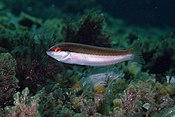bio.wikisort.org - Animal
The Mediterranean rainbow wrasse (Coris julis) is a small, colourful fish in the family Labridae. It can be found in the Mediterranean Sea and in the northeast Atlantic Ocean from Sweden to Senegal (though it is a rare wanderer to the southern British Isles).[3][2] Records of this species south from Senegal and the Cape Verde Islands are actually the closely related Coris atlantica.[2]
| Mediterranean rainbow wrasse | |
|---|---|
 | |
| Male in the coast of Santander (Spain) | |
Conservation status | |
| Scientific classification | |
| Kingdom: | Animalia |
| Phylum: | Chordata |
| Class: | Actinopterygii |
| Order: | Labriformes |
| Family: | Labridae |
| Genus: | Coris |
| Species: | C. julis |
| Binomial name | |
| Coris julis (Linnaeus, 1758) | |
| Synonyms[2] | |
| |
It feeds on amphipods, isopods, sea urchins, polychaete, shrimps, and small gastropods.[2]
Description

Like many wrasses, C. julis is a sequential hermaphrodite: all start in the smaller initial phase. These initial-phase individuals (both females and males) can turn into the larger secondary-phase males.[4] At a length of about 18 cm (7.1 in), all individuals are secondary-phase males.[2] The maximum length for the species is 25 cm (9.8 in). There is a marked difference in the appearance of the two phases. In the Mediterranean Sea, the secondary-phase male is green, blue, or brown, with white belly, a dark blue spot over the ventral fin, and a bright orange band on the side, while the smaller primary-phase females and males are brown with yellowish sides and white bellies.[5] Populations in the Atlantic differ in colour and genetics from the Mediterranean population, but are maintained in a single species at present.[1][4] If found to be separate, the scientific name Coris festiva (at present considered a synonym of C. julis) is available for the Atlantic population.
Habitat
It is typically found near the shore in places with seagrass or rocks. It is usually found at depths of 0–60 m (0–197 ft), but occurs as deep as 120 m (390 ft).[2]
References
- Pollard, D.; Afonso, P. (2010). "Coris julis". IUCN Red List of Threatened Species. 2010: e.T187752A8621739. doi:10.2305/IUCN.UK.2010-4.RLTS.T187752A8621739.en. Retrieved 20 November 2021.
- Froese, Rainer; Pauly, Daniel (eds.) (2019). "Coris julis" in FishBase. August 2019 version.
- Dr Amanda Young. "Wrasse (British Seas)". British Marine Life Study Society. Retrieved 2 February 2017.
- Aurelle, D., Guillemaud, T., Afonso, P., Morato, T., Wirtz, P., Santos, R.S.S., and Cancela, M.L. (2003). Genetic study of Coris julis (Osteichthyes, Perciformes, Labridae) evolutionary history and dispersal abilities. Comptes Rendus Biologies 326(8): 771-785.
- Egidio Patrick Louisy Trainito, ed. (2006). Guida all'identificazione dei pesci marini d'Europa e del Mediterraneo. Milan: Il Castello. ISBN 88-8039-472-X.
External links
- Photos of Mediterranean rainbow wrasse on Sealife Collection
На других языках
- [en] Mediterranean rainbow wrasse
[es] Coris julis
La doncella o budión (Coris julis) es un pez teleósteo de la familia Labridae, del suborden de los Acantopterigios, caracterizado por los dobles labios carnosos que cubren sus mandíbulas. Es de forma oblonga, está revestido de escamas y su carne es bastante apreciada. Se puede encontrar en los fondos de escasa profundidad en el mar Mediterráneo, donde es muy común, y en las costas del este del océano Atlántico, desde Escocia hasta Gabón, incluyendo las costas de las islas Canarias. Puede medir hasta 25 cm de longitud, presenta una coloración muy viva y, cuando percibe peligro, o durante la noche, se entierra en la arena.[ru] Морской юнкер
Морской юнкер[1], устаревшее радужник[2] (Coris julis) — вид морских костистых рыб из семейства губановых (Labridae). Распространены в Средиземном и Чёрном морях и в восточной части Атлантического океана. Живут недалеко от побережья на глубине до 120 м. Главная особенность этих рыб заключается в том, что они являются последовательными гермафродитами: в течение жизни самка становится самцом, меняя при этом не только пол, но и цвет. Длина тела достигает 25 см. Разводится в морских аквариумах.Другой контент может иметь иную лицензию. Перед использованием материалов сайта WikiSort.org внимательно изучите правила лицензирования конкретных элементов наполнения сайта.
WikiSort.org - проект по пересортировке и дополнению контента Википедии
